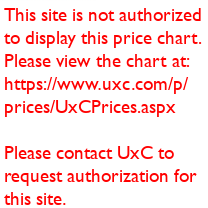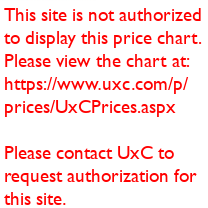Adding Transparency and Clarity to Uranium Prices
It is certainly not an understatement that the uranium market has undergone substantial changes during this decade, most notably in terms of price and price reporting. For those that have followed the market section of the Ux Weekly during this period, you have seen it grow from one to three (and in some cases four) pages in length. This has been due both to the additional price information introduced and displayed on these pages, as well as the additional commentary accompanying our price information.
So far this decade, we introduced the Ux Long-Term U3O8 Price in 2004, and the UX futures price (in conjunction with NYMEX) in 2007. In July 2007, we also started reporting bids and offers posted by the brokers, initially using data provided by Tullett Prebon. This was followed in September 2008 with bid and offer information reported by MF Global. This information now appears in the market section and is updated regularly.
With this background, it should not be entirely surprising that the next stage in the evolution of uranium price reporting is a daily price, which we are introducing with this issue of the Ux Weekly. Over twenty years ago, Ux was the first to break ground with a weekly price, which is now the standard of the industry and the price on which the uranium futures market is based. Of course, a finer delineation of prices is desirable as price fluctuates throughout the entire week, not just on certain days. As the spot market has become more active, and price data have been more readily disseminated, the reporting of a daily price has become possible.
The daily price that we will publish is based on bid and offer information supplied by three of the industry’s leading brokers – ICAP, MF Global, and Tullett Prebon. The price (the UxC Broker Average Price or BAP) is an average midpoint of the best bids and offers reported by the brokers; the average bid and offer prices will also be published, as shown in the chart above. The UxC BAP definition is provided on page 5. The daily UxC BAP will be made available through email updates and posted on UxC's Subscriber Services website.
In doing this, we will continue to publish the weekly Ux U3O8 Price as we have for the past 22 years. Our aim is to incorporate this broker-averaged price more formally into the Ux U3O8 Price index after a period of time. However, this will only happen once we are confident that the time series is reliable and sustainable, thus justifying this step. As shown in the chart, even though we are only introducing the daily price today, we have been collecting and aggregating this information from the brokers for some time now. Therefore, the time series has already started, and the system to implement it has been thoroughly tested.
A more formal incorporation of the broker prices into the Ux U3O8 Price will not be a big step as the market has already realized the influence of the broker postings. Furthermore, UxC collects and uses any valid verifiable offer data, including that of the broker's prices in formulating the Ux U3O8 Price. The extremely close correspondence between the Ux U3O8 Price and the midpoint of the UxC BAP is shown in the chart.
In today’s market there is no need to wait until Monday or Friday evenings to ascertain the uranium price; you are made aware of it every day by the posting of broker bids and offers. This is simply a fact of the current market. We anticipate that with the advent of new players in the market, including financial entities, the spot market will only become more active over time.
At the same time that we affirm our continued publication of the Ux U3O8 Price, we also want to state our intent to continue publishing the Ux U3O8 Long-Term Price, provided that we receive sufficient support from the industry to do so. We can also state here that we will not publish a so-called “mid-term” price, or a price that relates to a period longer than what the spot price covers but shorter than that covered by a long-term contract. Rather, it is our intent to publish a forward price curve, which relates the uranium price to deliveries at different points of time in the future. This forward price curve will be developed in a fashion akin to how we are reporting the daily price, and represents another benefit of working with the brokers who report a wide variety of price information, including forward prices.
Having complete and more transparent price data is essential to the proper operation of the market. This will become clearer in the future as the nuclear renaissance gains momentum. As a consequence, uranium requirements will increase tremendously, to as much as 400 million pounds per year by 2030 based on UxC’s new high requirements case. The market needs reliable price signals and sufficient liquidity so that investments can be made and price risk mitigated by buyers and sellers alike.
At the same time, we cannot talk about price transparency without being transparent on how we report prices. Therefore, we will provide more details of how the UxC BAP and other price series will be determined in our various publications and websites in the coming months to keep the industry fully briefed on these matters.
Our goal is to supply market information and analysis to the industry to underpin the successful operation of the market. This information is not just limited to spot prices or to the uranium market, but includes all fuel cycle prices along with long-term outlooks for these prices. In this regard, while we embark on reporting daily spot prices here, we are also looking at extending our price forecast horizon to 2040 and enhancing our reporting of long-term uranium prices, as well as conversion and enrichment prices.
In order to accomplish these goals, we obviously need the industry’s support and feedback. To this end, we welcome your comments. For our part, we will continue to expand our resources and efforts in the collection and dissemination of price information to meet the needs of a growing industry.


